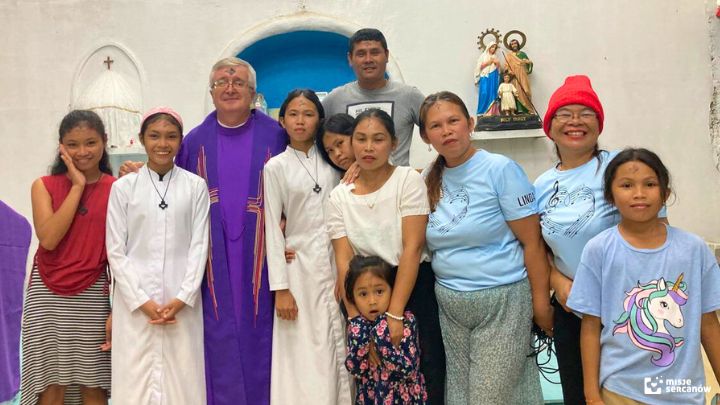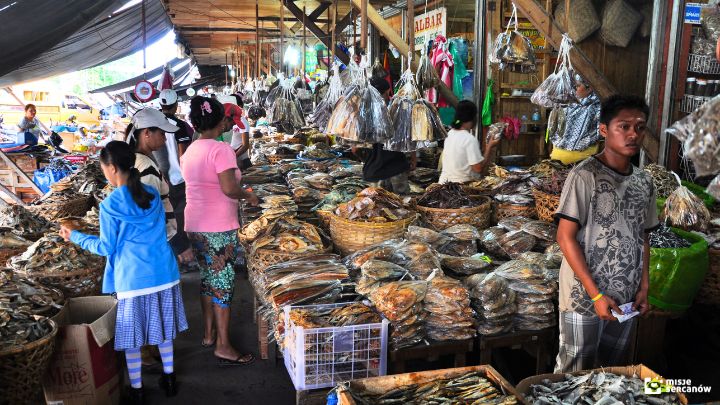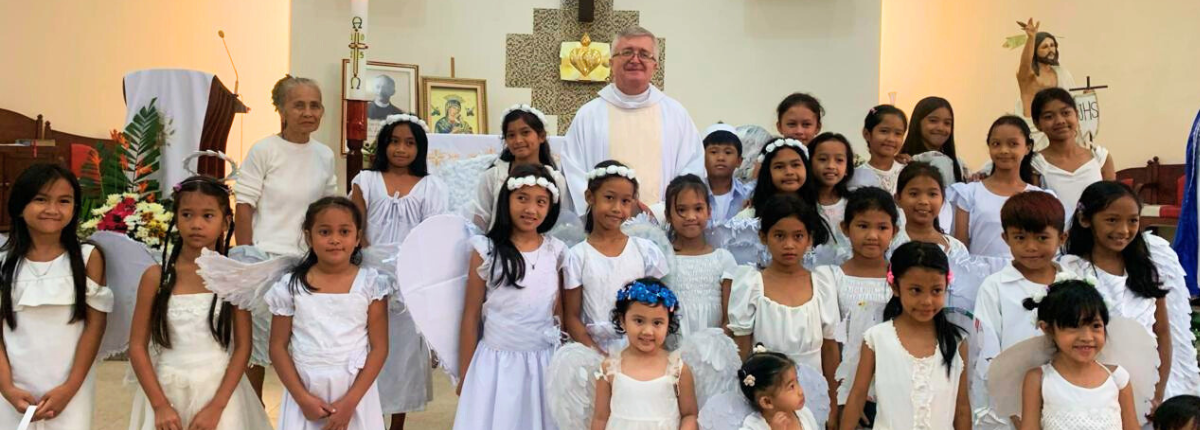Father Janusz Burzawa SCJ talks about the celebration of Lent and Easter in the Philippines.
People in the Philippines are more mindful of Valentine's Day than the start of Lent. That's why we print large colorful banners before Lent, calling for prayer, fasting and almsgiving, to make people aware that this time has arrived. We weave them along the main road so that people will at least see them, maybe it will move them in some way, maybe it will help them somehow.
-1746107141.jpg)
Ash Wednesday
As in all parts of the world, Lent in the Philippines begins on Ash Wednesday. However, ash is not sprinkled on heads here, but the sign of the cross is made on the forehead with it. It is likely that this custom, practiced mainly in English-speaking countries, is the influence of missionaries from the United States.
In villages which we can't visit on that day, the ministers celebrate the liturgy of the Word in the chapels. They also then make the sign of the cross with ash on the foreheads of the faithful. It is very common that even schools ask for a ministers to come and mark the children with ashes on that day. However, I ask then that this be done with dignity, that there be a common prayer in each classroom, and that the ministers explain what this day is all about. Only then do they make the sign of the cross on the foreheads of the children.
We have one problem with this sign of the beginning of Lent, because people think that if they are marked with a cross of ashes, they can't eat meat for the next 40 days. We don't know ourselves where this "misunderstanding" comes from. Perhaps the missionaries' intentions were misunderstood, and so it has remained in people's minds.

Fasting
The issue of fasting is a small problem in the Philippines - people think they are continually fasting. The early missionaries mistakenly transferred our fasting away from meat to a country where fish is the food of the day. Missionaries in Europe ate fish on Friday, which was perhaps unpalatable and expensive, and it was a financial and taste sacrifice. In the Philippines, fish is cheap and tasty. People eat it every day - morning, noon, evening. That is, in "European" terms, they actually fast every day. Meat, on the other hand, is very rarely served, making it a "rarity," and it is not the best prepared, because it needs to be cooked longer, and Filipinos do not have coal or gas, but bake or cook for a long time over a stick fire, and still very often the meat is undercooked.
That's why people don't understand much about fasting. We, of course, try to correct this, that it's not just fasting from meat, it's fasting from things that make our lives too pleasant, obscuring what is more important. That's why I'm suggesting more to people to renounce something, to refrain from using the cell phone, from playing on the computer or just wasting time. But also from drinking alcohol, which is a huge problem in the Philippines.
Filipinos are poor, which is why I hear very often that they "fast every day." I say it's not fasting, because it's not their own effort, their own putting, it's not of their own volition that they eat so miserably. Does it hit? Maybe to some yes, but we don't stop educating people so religiously.

Almsgiving
We prepare the alms already two or three weeks in advance. We look for mineral water bottles, make holes in them for pennies, because they won't fit through the neck, and glue a piece of paper that says Alay Kapwa - almsgiving. This action is very well organized by the Episcopate of the Philippines. This alms every year is divided between the parish, the diocese and the Episcopate of the Philippines, which when there are all kinds of natural disasters, and there are a lot of them in the Philippines, distributes this money.
Normally envelopes are distributed, but I just made these bottles, because in the villages it is easy to lose such an envelope, destroy it, and most often it is not the fault of the people. These bottles are such piggy banks, which for the whole 40 days are also some kind of challenge. Because you put 20 pesos in the envelope once from your wallet and forget about the issue, done. And in the bottle everyone can throw something: children a small penny, and a paper money mom or dad, or a brother or sister who works.
These bottles people bring during Holy Week. Part of the money that stays for the parish is a great help to us. Especially when people ask us for money for medicine. Thank God it never happens that someone goes without help. Most of the time we go to the city, buy medicine, so that we don't give money, because the money can easily be spent on other things, or buying those medicines that are cheaper but of poorer quality. From this almsgiving for such purposes, we have enough money for a whole year.
-1746107159.jpg)
Pastoral card
The alms bottles come with all sorts of "pastoral aids." This year it was a card with a preparation for confession, an account of conscience and a formula for confession. It happens that people are often embarrassed to go to the confessional because they have forgotten the words of the formula and are ashamed of the priest.
We've also included a list of ideas for Lenten resolutions to give people suggestions on how they can express their penance, their fasting and prayer. When praying, we suggest they come to the Stations of the Cross. We have also added Sunday Gospels with meditations for Lent for people to pray in this way at home. Every year we come up with something to somehow pastorally enrich this time. Because it should be made clear that Lent is not celebrated much in the Philippines. Holy Week very much so. And we would like to extend this preparation for Easter to all of Lent, not just Holy Week.
.jpg)
Way of the Cross
In Lent, of course, we have Stations of the Cross, very often in chapels. I try to make them take place outside, so that people walk in the streets, be visible. On a daily basis, people don't remember too much that it's Lent... That's why on Friday morning the ladies of the parish go around the houses and distribute printed images of the next Stations of the Cross. For each of the six Fridays of Lent for all Stations of the Cross we have prepared meditations - short, concise, accessible, so as not to repeat the same thing.
Stations of the Cross are in all the villages, and while maybe not too many people come to them, when you multiply that by the 37 villages we have, you get a little bit of people. Especially children like to come, because they carry candles. This is also such an attraction for them. Well, and they look at these paintings, at the images from Calvary, which maybe tell them more than the reflections we read.
.jpg)
Lenten retreats
In the parish we have a one-day retreat. We start at 8:00 am. From 9:00 a.m. there was a Jesuit Priest who prepared people for confession and preached the retreat teachings. Around 12:00 we distribute a simple lunch to all those who come from the villages. We have as many as 37 of them, and they are scattered over large distances, so people need to be given food. After lunch we do an exposition of the Blessed Sacrament, and in the afternoon there is confession. Of course, we ask priests to come to help with confession, because last time there were almost 400 people, with two of us we wouldn't be able to confess everyone. In Lent we also go to confess in the villages. This is also the time when the school year ends and children have such days of retreat, during which there is also confession. This year a lot of people have confessed and we are very happy about that.
-1746108180.jpg)
Holy Week
Holy Week is a completely different story. As I said at the beginning, in the Philippines everything is focused on this Holy Week. It's a time of all sorts of prayers and pilgrimages. Every day of Holy Week until Good Friday is the Stations of the Cross at 4:00 am, it's such a tradition in the Philippines. Why at 4:00 am? Because it's cool and people aren't at work yet. At 6:00 a.m., when the Stations of the Cross end, that's the time to have breakfast and go to work.
-1746108170.jpg)
Palm Sunday
Holy Week begins, of course, with Palm Sunday. Already on Saturday morning people come, bring down palms and arrange them, weave them into all sorts of crosses, flowers, birds. They make the most varied things from these young palm shoots. Churches are decorated almost only with palms.
Palm Sunday begins outside the church with a short procession, blessing and blessing of palms. Filipinos pin them very often on the doors of their homes. We say that through these palms they should welcome Christ. What kind of Christ? The Christ who is in those poor people who need Him.
.jpg)
Maundy Thursday
Washing feet in the Philippines on Maundy Thursday is an obligation. Men who are prepared for this washing of feet should be on retreat, confess, and we are looking for those men who do not usually go to church. Through this we try to make more men somehow dare to come to church. And this gives results, because very often these men get more involved in the Church later, and very often they agree to become ministers.
After the Mass of the Lord's Supper, there is a dinner prepared by the community for those gentlemen who participated in the celebration. Dinner is an opportunity to talk, I ask them about what they do, whether they have families, and invite them to cooperate and get involved in the life of the parish.
.jpg)
Good Friday
In the Philippines, Good Friday is a public holiday. Everything is closed - you won't buy anything, not even gas up at the gas station.
Good Friday begins with the Stations of the Cross. It is with longer reflections, so sometimes it can be very long. After this Way of the Cross, people eat a cup of such "pap" consisting of: shredded banana, rice, fruit and other sweets. This is an expression of their fasting, because they do not eat such pap, and in this way they show that they are fasting on Good Friday. Well, and this is very popular. All the things for this pap at this time are very expensive. On Saturday morning it can no longer be sold, because no one buys it anymore.
At 1pm the Palabras, or the Seven Last Words of the Lord Jesus, begin. Prepared meditations are read. Very often these meditations are based on people's lives, they are emotional, and people cry while listening to them. Palabras last nearly two hours. Hymns are sung between the meditations. We Europeans may have a different sensibility, but this prayer is very beautiful, it helps to realize what Christ went through and that we are going through it too. Or rather that what we are going through, Jesus also went through.
15 minutes before 3:00 pm we pray the Divine Mercy chaplet. This is the first day of the novena before Mercy Sunday. After the chaplet, the liturgy begins with the kissing of the cross.
In many larger parishes it is also customary to go around the parish with a statue of the body of the deceased Jesus - Santo Entierro. The Lord Jesus lies in such a coffin, very often glazed, so that people can see Him, and this statue is circled through the streets of the entire parish. Later they return to the church and there is adoration or vigil until evening.
.jpg)
Holy Saturday
Preparations for Holy Saturday are quite complicated, because the liturgy is very elaborate. This year the liturgy was in a new village, and it was difficult because people are not familiar with the rites. And in the evening it was already a celebration.
Filipinos are eagerly awaiting this celebration, because it is very lively. The fire is often lit by some kind of bucket that is on fire and from a large palm tree it flies down to the ground like lightning. We discourage such things for safety reasons. The Paschal is carried into the church, the Exsultet is read, then the readings. During "Glory on High," the altar is dressed, decorated and the veils are pulled down from the saints and the cross.
The homily is followed by the blessing of baptismal water, but people also bring their water and we bless it. It's not baptismal water, but very often they use it at home to ruminate or sprinkle. The celebration ends late in the evening, around 9:00 pm, well, and we start preparing for the Resurrection.
.jpg)
Resurrection Sunday
Easter Sunday in all parishes begins with the celebration of Sugat. Sugat means "going out to meet someone." This celebration reflects what is not found in the Bible, but has been in the hearts of Christians probably since the beginning of Christianity, which is the belief that the Lord Jesus, after his Resurrection, first went to the Mother of God to tell her that everything was over, that her suffering was over, that she could now rejoice. Filipinos believe that when they come back from a long trip, they first go home, leave their luggage, greet their mother, their father, tell them what happened there, and then run to their friends to talk to them. That's what Jesus did. The Sugat celebration was approved by the Vatican decades ago. It is a Mass with prayers, with a preface about the Mother of God, obviously in the context of the Resurrection.
This Mass is preceded by a performance, say theatrical and religious. For two weeks before the Resurrection, children learn chants for the celebration. The children dress up as angels (in the Philippines we have angels during Easter), and what do these angels do? Well, they sing to Our Lady not to worry, not to cry, that everything will be fine. The women bring a statue of the Mother of God on one side of the village, and the men bring a statue of the Risen Christ on the other. And this is their meeting. The Mother of God meets her Son, or the Lord Jesus meets his Mother. This is called Sugat. At this time the angel children sing beautifully. There is also a "chief angel" who approaches the Mother of God dressed in a black veil. The angel takes this veil, pulls it from Her head and says: "Do not grieve, Mary, your Son is risen, He is alive." Then he puts a nice white veil on Her. At this point, all the children sing "Alleluia," because Jesus is alive. At this point, the Mass begins, very often celebrated outside the church, because the temple cannot accommodate the people.
.jpg)
Searching for depth and meaning
In the booklet that each family received, we explained what Holy Week was all about, so that these church celebrations would somehow carry over into family life. There was a prayer, a blessing for the family on Maundy Thursday, a thanksgiving for the graces we received from God, so that God would show us favor through various kinds of events, just like the Israelites. On Good Friday, I asked in this booklet that they clean the crosses in their homes, dress them and kiss them. On Holy Saturday or Resurrection Sunday, they would put those candles they received at the Paschal Vigil and the water we blessed on the table and light a candle, pour the water on some plate, made the sign of the cross with this water and prayed with the whole family so that Sunday breakfast or lunch would be a little different.
How it works, we don't know yet. But people are gradually understanding that these holidays should go beyond the walls of the church. So that those who stay at home also get a taste of what happens in the Christian community on these holy days.
.jpg)
Learn about the missionary project led by Father Janusz Burzawa SCJ - Feeding and Education of the kids in Opol.



